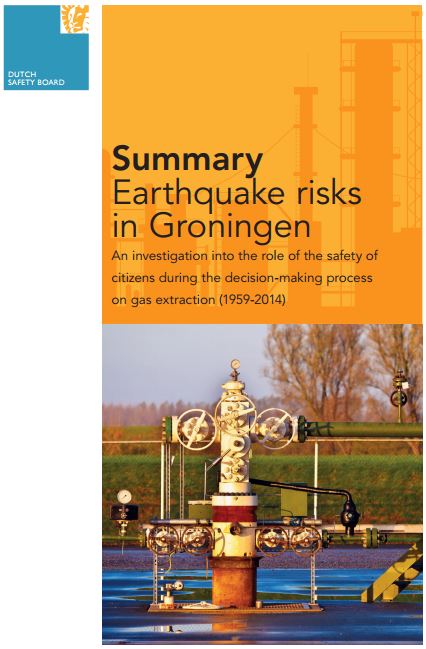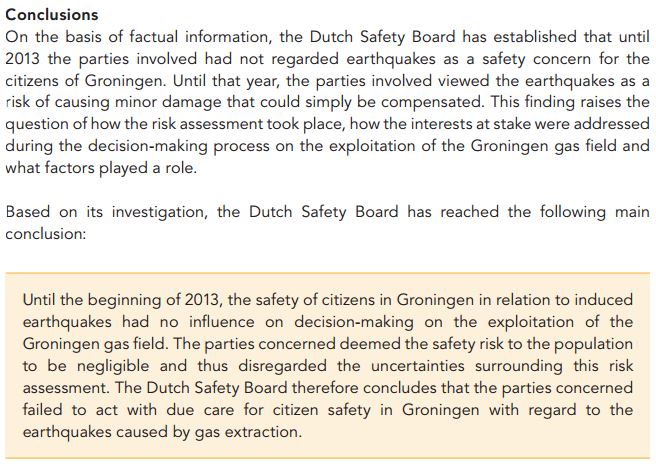Netherlands court orders gas companies to pay for quake damage by Matt Belenky, September 2015, Jurist
A Netherlands court ruled on Wednesday that a Royal Dutch Shell and Exxon Mobil joint venture must pay homeowners for property damage caused by gas drilling related earthquakes. The Dutch Safety Board has warned several times in the past few years that natural gas production in Groningen field area increases earthquake risk, and that companies have not done enough to mitigate the risk. Nearly a hundred thousand homes and buildings were damaged in the quakes, with damage estimates in the billions. [Emphasis added]
Dutch Court Finds Gas Venture Liable for Earthquake Claims by Reuters, September 2, 2015
A court in the Netherlands ruled on Wednesday that a natural gas company, a joint venture by Royal Dutch Shell and Exxon Mobil, must compensate homeowners for declines in the value of their properties because of earthquakes linked to production at Europe’s largest gas field, the Groningen field. The ruling by the court in Assen could result in billions of euros of claims against the venture, known as NAM. The Netherlands has twice this year reduced production from the field after the Dutch Safety Board, a government-financed but independent organization, said gas companies and regulators had failed to take the danger from gas-production-linked earthquakes seriously enough. [Emphasis added]
This is lawsuit land and frackers can feel tremors all the way from Netherlands by Andrew Dewson, September 8, 2015, US Outlook in The Independent
A case decided in the Netherlands on Wednesday could have huge implications for the American shale industry. Shell and Exxon, the world’s largest oil companies, have been ordered to pay compensation to homeowners over the fall in the value of their homes due to seismic activity around the massive Groeningen gas field. The two companies which operate the field through a joint venture called Nederlandse Aardolie Maatschappij (thankfully usually referred to as NAM), have already put aside $1.4 billion (£920 million) to compensate 900 homeowners and 12 housing associations.
That could be the tip of the iceberg and many other households will fancy their chances of getting compensation, whether they were trying to sell their homes or not. There is a good chance most of them will receive something, and if heavyweights like Shell and Exxon, and their armies of well-paid lawyers, can lose such a case then smaller production companies ought to be terrified – especially those involved in fracking.
A Shell spokesman admitted that the decline in the value of the homes is directly linked to an increase in seismic activity at the gas field: “We recognise the concern of residents and agree that in specific cases earthquakes can cause a decline in value.”
It was stating the obvious perhaps, but it is also the first time a big oil producer has admitted that drilling is directly connected to seismic shifts.
….in particular Oklahoma, where one in six jobs is in the oil industry and almost all of them are fracking-related. [Time to start creating more economical, less risky and damaging jobs, isn’t it?] Earthquakes used to be a rare occurrence in the “Sooner State”, but over the past 10 years or so they have become an everyday occurrence, with 508 in 2014 alone.
The Groeningen case is somewhat difference – drilling in a single gas field rather than fracking – but there are enough parallels to make every shale company sit up and pay attention.
Only oil industry diehards could deny the link between fracking and earthquakes. The US Geological Survey’s public position is that injecting billions of gallons of water into the earth’s surface rock is the primary cause of increased seismic activity in states such as Oklahoma and Pennsylvania. Most activity is low on Richter scale – quakes that won’t inflict immediate or significant damage, but that over time, and if frequent enough, will cause homes to crumble. After hundreds of small quakes, many homes in Oklahoma are displaying severe signs of deterioration. [And when 100,000 homes are quaked unsafe and unlivable by the oil and gas industry? What about 1,000,000 homes?]
Damage to homes is probably the least of the fracking industry’s concern right now. [That’s precisely the problem with the industry]
… That doesn’t mean anyone unfortunate enough to be living in a crumbling, worthless home shouldn’t do anything about it; the industry’s ill-gotten gains have been piling up for long-enough. … The fracking industry has become incredibly profitable while externalising a very significant cost on to ordinary people, most of whom have gained little.
Nobody’s property should crumble without reasonable compensation. Oklahoma homeowners should take inspiration from Groeningen and take the fracking industry to the cleaners. [And when 100,000 homes crash in on families and kill them because of fracquaking, preventing them from suing?]
Earthquake risks in Groningen, An investigation into the role of the safety of citizens during the decision-making process on gas extraction by Dutch Safety Board, Board member for the project: Prof. mr. dr. Erwin Muller, The Hague, February 2015
Introduction
On 16 August 2012 the village of Huizinge in the province of Groningen was rocked by an earthquake with a magnitude of 3.6 on the Richter scale. It was the worst earthquake caused by gas extraction that had been observed thus far in the Netherlands. The quake caused a lot of damage and led to concern.
The confidence of residents in the safety of the gas extraction and the parties involved reached a low point. The Dutch Safety Board having followed the case for some time already, decided in early 2014 to launch an investigation. The Dutch Safety Board has investigated the decision making process on gas extraction in Groningen and has particularly looked at how the safety of residents in relation to earthquakes is considered. This investigation covers the period from the discovery of the Groningen gas fields in 1959 to the presentation of the package of measures by the Minister of Economic Affairs in January 2014. [Emphasis added]
…
Studies suggested that the intensity of future earthquakes would be minimal and even though the maximum intensity had been adjusted upward on a number of occasions, the parties responsible for gas extraction ruled out the idea that the earthquakes would lead to personal accidents. The earthquake in the village of Huizinge in 2012 dispelled this optimistic belief. Since the supervisory authority’s warning in early 2013, many people viewed the earthquakes not just as a damage issue but also as a threat to the safety of the citizens of Groningen. The reassuring certainty that the intensity of the earthquakes would not exceed a certain value had vanished.
…
Can citizens rely on incidents being prevented, damage being limited, risks being controlled and uncertainties being explored? The term citizen safety is broadly defined: the residents of Groningen must be safe and feel safe in their daily living environment.
…
This report…does not answer the question of how high the risk is to which residents in the gas extraction area are exposed.
…
Citizens’ confidence in safe gas extraction as well as in the parties involved has tumbled.
Until 2013, no integral, independent scientific research programme had been initiated to chart the deep substratum of Groningen and the mechanisms at work underground. Furthermore, the parties involved were unreceptive to critical viewpoints that called the accuracy of the assumptions into question. In the Dutch Safety Board’s opinion, the parties concerned should have already realized at an early stage that unknown risks would be inherent in a large-scale, multi-year operation such as the exploration of the Groningen gas field. Uncertainty and reducing that uncertainty should have served as guiding principle for their actions.
A third and final relevant factor is the inadequate level of accountability to, and communication with, the Groningen population. [Sound familiar?] … Communication focused primarily on the expected maximum earthquake intensity and the lighter material damage that could be caused by earthquakes. On account of this technocratic approach, insufficient consideration was given to the anxiety and safey concerns of the citizens in Groningen.
…
Much of the prevailing dissatisfaction in Groningen is rooted in the past. The people of Groningen refer to the perior – now almost 25 years ago – in which the exploration company catergorically maintained that the earthquakes could not have anything to do with gas extraction. When a relationship with gas extraction was nonetheless found to exist, the first crack in NAM’s credibility became a fact. This pattern subsequently repeatedly itself. The earthquakes would only cause slight damage at the most – considerable damage occurred nonetheless. The severity of the earthquakes would not exeed 3.3 on the Richter scale – but they did nonetheless. The supervisory authority warned that citizen safety in the gas extracation area was at risk and recommended that extraction be reduced – and nonetheless in 2013 more gas was extracted in Groningen gas field. The Groningen population’s confidence in both NAM and the central government then plunged to an all-time low.
…


